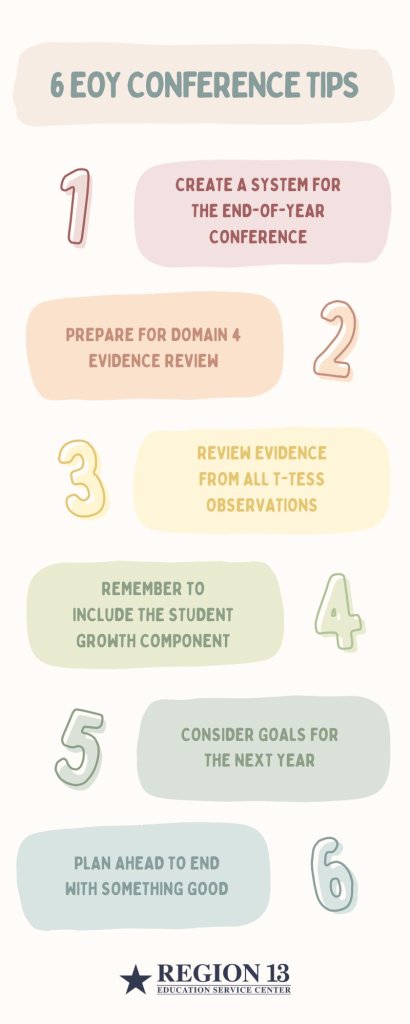A high-speed roller coaster is a metaphor for the academic school year, with all its twists, turns, surprise drops, and even the ultimate upside-down spins. While this roller coaster spins inexorably toward that final day, an important activity must occur at least a few weeks before the last student day: End-of-Year (EOY) conferences between the teacher and appraiser.
These conferences are on the to-do list for both parties but are so much more than a compliance item or a check-the-box activity. Here are a few tips for teacher appraisers to consider as they prepare for an impactful and empowering End-of-Year conference with each teacher.
1. Create a System for the End-of-Year Conference
Determine how you will organize your calendar and resources to manage your time and provide the most impactful experience for the teacher. Consider how teachers should share meaningful Domain 4 evidence with you without unnecessarily burdening the teacher or you.
When you schedule the End-of-Year conference with the teachers, schedule time on your calendar to prepare. You will need at least 30 minutes of preparation time for each conference. This could take much longer if you do not manage your time carefully. Here are some suggestions:
- 10 minutes to review evidence from observations (formal and informal).
- 10 minutes to review the evidence you and the teacher shared for Domain 4, including reviewing goals.
- 10 minutes to review the teacher’s goals and draft the EOY conference feedback summary for Domains 1-3 of T-TESS.
Following the conference, you will need to block time to finalize the rating for Domain 4 and share it with the teacher. More about Domain 4 below.
2. Prepare for Domain 4 Evidence Review
Prior to the conference, as an appraiser, you will want to ensure that you have a good understanding of the T-TESS Rubric for Domain 4, Professional Practices and Responsibilities, or for the appropriate section of the evaluation tool you are using. Regarding T-TESS, Domain 4 has not yet been directly addressed in formal evaluation, though both you and teachers have likely tracked some evidence throughout the year. Revisit the expectations from the beginning of the year.
As an appraiser, you will ensure that the teacher has an opportunity to discuss the evidence for Domain 4 during the conference. You may ask them to share this before the meeting so that you can review it and prepare to discuss it. You will determine the rating for Domain 4 once the teacher has shared and discussed their evidence with you.
Additionally, you will share the rating of Domain 4 with the teacher in writing following the EOY conference. Remember, the rating is about the impact on the campus, the students, the community, and the district rather than a defined formula of compliance checks for how many meetings or hours of professional development were attended.

3. Review Evidence From All T-TESS Observations
You should review all evidence and written feedback that you and other administrators have collected during this school year (aligned with guidance for the evaluation system). Consider if the teacher has grown from the coaching and feedback you have provided since the earliest observation.
The formal observation(s) were likely conducted early in the school year to increase the positive impact on student learning as the teacher continues to refine effective instructional practices. Consider the evidence collected over multiple visits to the classroom. The teacher has probably improved over the year with consistent follow-up on feedback and coaching, so the ratings may have shifted since the formal observation.
Also, the evidence from multiple visits will confirm if positive practices are implemented consistently. Consider the teacher’s effectiveness based on the preponderance of evidence and their performance at the end of the year.
4. Remember to Include the Student Growth Component
The district determines the method used to measure student growth. Your teachers may be using Texas Student Learning Objectives, a process embedded in instruction likely to impact student learning and teacher practices positively. Other options include pre/post assessments, portfolios, and value-added measures (VAM).
If using pre/post-tests, you may not have all the data in time for the End-of-Year conference, but you can briefly discuss student growth and let the teacher know you will follow up if the data is received by the end of the year. You may have to follow up at the beginning of the next school year when you have all the data. You can find the Texas SLO rubric and other resources at texasslo.org.
5. Consider Goals for the Next Year
As you prepare for each conference, remember that the T-TESS process is cyclical, and at the End-of-Year conference, you and the teacher will discuss possible goals to continue their growth journey.
While you will not set goals for teachers and will need to consider their progress on current goals during the conference, it is helpful to think about the teacher’s goals and learning needs to support a productive end-of-year conference. You should also consider how you will support the teacher and what resources you can offer.
6. Plan Ahead to End with Something Good
Educators desire to have a positive impact on their students. Every teacher deserves to hear something they are doing well, or at least relatively well, for their students. Plan to share something positive with the teacher, even though there still may be challenges.
Planning and preparation for these important conferences can lighten your load and optimize the effectiveness of your End-of-Year conferences. Remember, at the meeting, you can bring things full circle by demonstrating your engagement as a partner with the teacher and continuing to build a professional relationship that supports continuous growth.
LaWanda Carley is a Senior Coordinator for Educator Evaluation and Leadership here at Region 13.





Add comment